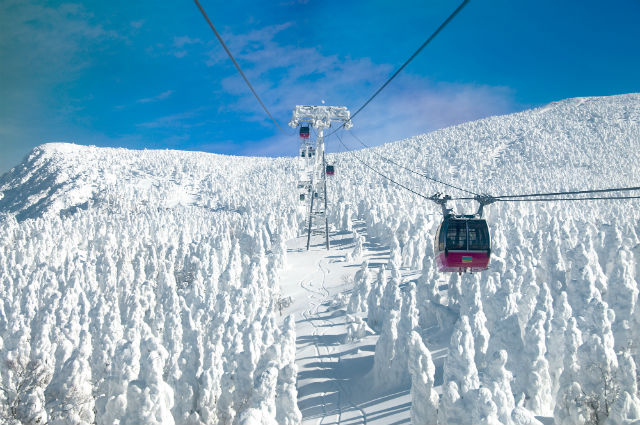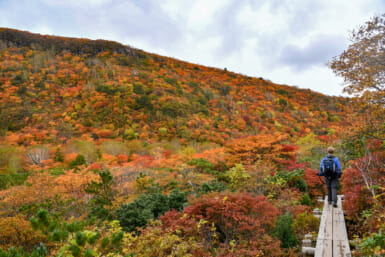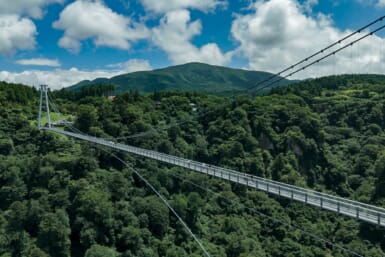While many hardcore snow fiends head all the way up to Hokkaido to get their fix, there’s plenty of the white stuff to go around in Kanto. Here’s our guide to getting your ride on.
By Phil Luza
It’s no secret that Japan has some of the greatest skiing and snowboarding on the planet. With some of the world’s highest annual snowfall, the country has long been on the radar for powder hunters. Thanks to a myriad of resorts to choose from—ranging from tiny bubble-era destinations with a few runs to high-tech mega resorts that offer a great experience for everyone from beginners to seasoned pros—it belongs on every winter sports enthusiast’s bucket list.
Living and exploring northern Honshu has left a soft spot in my heart for its snowy winters and huge variety of mountains. The broad range of course difficulties and the combination of modern convenience and traditional Japanese culture makes each trip a memorable experience. Winter in Japan offers a unique opportunity to explore a wide range of mountain ranges and embrace seasonal cuisine, spectacular festivals, and a relaxing soak in an onsen.
Tokyo offers great access to resort destinations in the Honshu area for hardcore powder hunters and weekend warriors in addition to weekend getaways and family vacations.
Weekend Getaway
One of the most popular getaways is Gala Yuzawa in Niigata Prefecture. It’s only 80 minutes from Tokyo on the Joetsu Shinkansen and the station connects directly to the gondola. Gala is one of the most hassle-free day trips from Tokyo and resort tickets are often packaged by JR East with the purchase of your Shinkansen ticket.
If you are looking to get a break from the crowds, explore, or have a unique experience, a trip to Zao Onsen Ski Resort is a great choice. Zao has less of a bubble-era feel and provides a more traditional Japanese setting, with ryokans and local onsen for a nice soak after a day on the mountain. Cold Siberian winds and an ample snowfall create the famous “snow monsters” (known as juhyo in Japanese) that attract visitors and skiers alike. Clumped ice and snow stick to the tall fir trees to create bizarre shapes that are more spectacular than spooky. The awe-inspiring setting and steep terrain offer an unforgettable getaway.
Nagano’s Shiga Kogen is by far Japan’s biggest ski resort area and is also home to the famous onsen-loving snow monkeys. The snow monkeys have lived in the Shiga Kogen area for several generations and visit the natural hot springs near the base of the mountain daily for a hot soak. The area is also a center of the Japanese craft beer renaissance and is home to some of the finest brews in the country.
The high altitude means Shiga Kogen consistently has great snow conditions, and with more than 20 interconnected ski resorts all accessible with one lift pass, there is a huge area to explore. The 1998 Nagano Winter Olympics women’s downhill, slalom, super-G and snowboarding events were held here. With more than 80 kilometers of trails there is terrain for every level of rider. For solo riders or those looking to explore these resorts and more the Tokyo Snow Club offers tours all winter. Trips often include tickets to local events, sightseeing, and are a guaranteed good time.
Getting Deep And Steep
If you are looking to beat the crowds and score some famous “Ja-pow” there are several ways to get off the groomed trails and go off-piste.
Nagano boasts some of the best snow in Japan: locals as well as international skiers and snowboarders flock there for the steep terrain, variety of resorts, and nearly endless powder.
Meanwhile, Hakuba is one of the largest snow resort areas in Japan—with over 12 meters of powder annually it’s easy to see why. Resorts like Cortina and Tsugaike offer great access to lift-accessed sidecountry and relatively mellow backcountry. There are also a large number of beginner and intermediate runs available. Myoko Kogen, near the border of Niigata, is a freeriders’ playground and also a great cultural setting. Created in the 1930s, Myoko derives its name from a Buddhist phrase that speaks about a “holy mountain standing in the center of the universe.” With off-piste and tree skiing permitted, and some of the longest and closest to vertical runs in Japan, it can be easy for any skiing devotee to find their own Nirvana.
Closer to Tokyo is Tenjindaira in Gunma Prefecture. Tenjindaira is regularly ranked in the top five Japanese resorts for snow depth and is one of Japan’s 100 “Famous Mountains.” Despite its proximity to Tokyo it’s often less crowded than farther-flung locations. It is not uncommon to be graced with 2–3 meters of fresh powder overnight and long untracked lines in the morning from the top of the mountain to the base of the gondola. To access some of the more extreme and remote lines using a guide is recommended. In Nagano the Tao of Pow and Hakuba Mountainlife provide bilingual and experienced guides with local knowledge. For adventuring in Tenjindaira check out Tenjin Lodge for backcountry tours and accommodation.
Winterland Retreat
For those looking for a relaxing day on the mountain and a deep soak in a hot spring, Nozawa Onsen offers a beautiful setting and selection. With traditional Japanese architecture lining the small cobblestone streets, the Edo-era town is renowned for its onsen and happens to have a great ski resort above it. Nozawa Onsen offers a great variety of beginner and intermediate runs in addition to off-piste riding. The ski resort is a short walk or ride on the covered escalator from the village.
Nozawa Onsen also offers a great variety of accommodations, including the modern traditional Japanese hotel Sayaka. The Michelin Guide recently granted the Sayaka a coveted 2-star rating. The Sakaya Ryokan is ideal for small families or groups and is located in the heart of the village.
Nozawa also hosts one of the most spectacular fire festivals in Japan every January 15th. The 42 and 25-year-old men (so called unlucky ages) of the village take on special roles of protecting a massive tower constructed from trees chopped down from the mountain in October. The festival is focused on celebrating the birth of a family’s first child, dispelling evil spirits, and on praying for a happy marriage. At night, villagers charge at the tower with torches. The 25-year-olds fight them off at the base and the 42-year-olds defend the top. The event climaxes in a massive bonfire as the tower is engulfed in the flames.
If you’re traveling with a group that enjoys après style skiing, consider the Bluebird Chalets in Hakuba. They’re modern, elegantly designed, and conveniently located a short stroll from the restaurants, cafés and bars in the heart of the town. Surrounding the chalets are Hakuba 47 and Happo ski areas, two of the largest and most popular resorts in Nagano.
How to get there:
Myoko Kogen – Shinkansen from Tokyo Station to Nagano, then the JR Shinetsu Line to Myoko Kogen (3.5-4 hrs)
Gala Yuzawa – Some direct trains available in winter between Tokyo Station and Gala Yuzawa; otherwise Joetsu Shinkansen to Echigo-Yuzawa and bus to Gala Yuzawa (1.5-2 hrs)
Zao Onsen – Shinkansen from Tokyo Station to Yamagata Station, then bus to Zao (~3.5 hrs)
Shiga Kogen – Shinkansen to Nagano, then bus to Shiga Kogen resorts (~3 hrs)
Hakuba – Shinkansen to Nagano, then bus to Hakuba (~3 hrs)
Tenjindaira – Joetsu Shinkansen from Tokyo Station to Echigo-Yuzawa, then JR Joetsu Line to Doai (~2 hrs)
Images: Shutterstock.com











